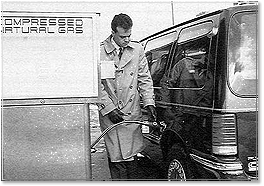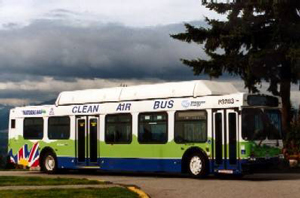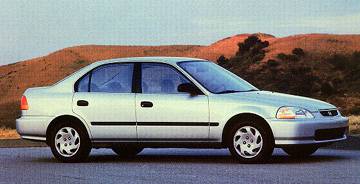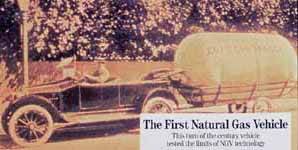Natural Gas in the Transportation Sector
Natural gas has long been considered an alternative fuel for the transportation sector. In fact, natural gas has been used to fuel vehicles since the 1930’s!
According to the Natural Gas Vehicle Coalition, there are currently 150,000 Natural Gas Vehicles (NGVs) on the road in the United States today, and more than 5 million NGVs worldwide. In fact, the transportation sector accounts for 3 percent of all natural gas used in the United States. In recent years, technology has improved to allow for a proliferation of natural gas vehicles, particularly for fuel intensive vehicle fleets, such as taxicabs and public buses. However, virtually all types of natural gas vehicles are either in production today for sale to the public or in development, from passenger cars, trucks, buses, vans, and even heavy-duty utility vehicles. Despite these advances, a number of disadvantages of NGVs prevent their mass-production. Limited range, trunk space, higher initial cost, and lack of refueling infrastructure pose impediments to the future spread of natural gas vehicles.
Most natural gas vehicles operate using compressed natural gas (CNG). This compressed gas is stored in similar fashion to a car’s gasoline tank, attached to the rear, top, or undercarriage of the vehicle in a tube shaped storage tank. A CNG tank can be filled in a similar manner, and in a similar amount of time, to a gasoline tank.
 |
| Refueling an NGV |
| Source: EREN – DOE |
This natural gas fuels a combustion engine similar to engines fueled by other sources. However, in a NGV, several components require modification to allow the engine to run efficiently on natural gas. In addition to using CNG, some natural gas vehicles are fueled by Liquefied Natural Gas (LNG). Some natural gas vehicles that exist today are bi-fuel vehicles, meaning they can use gasoline or natural gas, allowing for more flexibility in fuel choice. Many of these vehicles, which were originally gasoline only, have been converted to allow the vehicle to run on either fuel. This conversion is costly, and typically results in less efficient use of natural gas.
Why Natural Gas Vehicles?
There are many reasons why NGVs are increasing in abundance and popularity. New, stringent federal and state emissions laws require an improvement in vehicle emissions over the foreseeable future. For example, the state of California has some of the most stringent environmental standards, many of which are currently unattainable with conventionally fueled vehicles. Natural gas, being the cleanest burning alternative transportation fuel available today, offers an opportunity to meet these stringent environmental emissions standards.
In addition, natural gas is very safe. Being lighter than air, in the event of an accident natural gas simply dissipates into the air, instead of forming a dangerous flammable pool on the ground like other liquid fuels. This also prevents the pollution of ground water in the event of a spill. Natural gas fuel storage tanks on current NGVs are stronger and sturdier than gasoline tanks.
Natural gas is also an economic alternative to gasoline and other transportation fuels. Traditionally, natural gas vehicles have been around 30 percent cheaper than gasoline vehicles to refuel, and in many cases the maintenance costs for NGVs is lower than traditional gasoline vehicles. In addition to being economic, many proponents of NGVs argue that a transportation sector more reliant on domestically abundant natural gas will decrease the U.S. dependence on foreign oil – allowing for a more secure, safer energy supply for the country.
 |
| A ‘Clean Air’ Natural Gas Bus |
| Source: Duke Energy Gas Transmission Canada |
The Environmental Benefits of NGVs
One of the primary reasons for pursuing alternative fueled vehicle technology is to decrease environmentally harmful emissions. It is estimated that vehicles on the road account for 60 percent of carbon monoxide pollution, 29 percent of hydrocarbon emissions, and 31 percent of nitrogen oxide (NOx) emissions in the United States. All of these emissions released into the atmosphere contribute to smog pollution, and increase the levels of dangerous ground level ozone. Vehicles also account for the emission of over half of all dangerous air pollutants, and around 30 percent of total carbon emissions in the U.S., contributing to the presence of ‘greenhouse gases’ in the atmosphere. The environmental effects of NGVs are much less detrimental than traditionally fueled vehicles. More information on environmental standards is availbale at the Environmental Protection Agency (EPA).
Natural gas vehicles, when designed to run on natural gas alone, are among the cleanest vehicles in the world. In fact, the Honda Civic GX, released in 1997, has the cleanest internal combustion engine ever commercially produced. This natural gas powered automobile emits so few pollutants that in some large cities the emissions from the car are cleaner than the air surrounding it! California, with some of the tightest clean air standards anywhere in the United States, has recognized selected natural gas vehicles as meeting and exceeding its most stringent standards, including low-emission vehicle (LEV), ultra-low emission vehicle (ULEV), and super-low emission vehicle (SULEV) standards.
 |
| Honda Civic GX – Super Clean NGV |
| Source: AFDC – DOE |
Natural gas vehicles are much cleaner burning than traditionally fueled vehicles due to the chemical composition of natural gas. While natural gas is primarily methane, gasoline and diesel fuels contain numerous other harmful compounds that are released into the environment through vehicle exhaust. While natural gas may emit small amounts of ethane, propane, and butane when used as a vehicular fuel, it does not emit many of the other, more harmful substances emitted by the combustion of gasoline or diesel. These compounds include volatile organic compounds, sulfur dioxide, and nitrogen oxides (which combine in the atmosphere to produce ground level ozone), benzene, arsenic, nickel, and over 40 other substances classified as toxic by the EPA.
Dedicated NGVs also produce, on average, 70 percent less carbon monoxide, 87 percent less non-methane organic gas, and 87 percent less NOx than traditional gasoline powered vehicles.
For more information on the environmental benefits of natural gas vehicles, visit the Natural Gas Vehicle Coalition.
Who Uses Natural Gas Vehicles?
Natural gas vehicles as they exist today are best suited for large fleets of vehicles that drive many miles a day. Taxicabs, transit and school buses, airport shuttles, construction vehicles, garbage trucks, delivery vehicles, and public works vehicles are all well suited to natural gas fueling. Because these vehicles are centrally maintained and fueled, it is economical and beneficial to convert to natural gas.
 |
| Natural Gas Powered Public Transit |
| Source: NGSA |
The primary impediments to the public proliferation of NGVs include the high initial cost, limited refueling infrastructure, and automobile performance characteristics. NGVs, despite being cheaper to refuel and maintain, are more expensive initially than their gasoline powered counterparts. However, as the technology becomes more advanced, the cost of manufacturing these vehicles should drop, which may then be passed along to the consumers.
In terms of refueling infrastructure, there are currently around 1,500 natural gas refueling stations in the U.S., over half of which are open to the public. Although this is a small fraction of the number of gasoline fueling stations in the country, as environmental standards and government incentives for NGVs increase, supplying natural gas as a vehicular fuel will become increasingly common.
While driving range, storage space, and initial cost are currently preventing the mass production of dedicated natural gas vehicles (which in turn is preventing the expansion of public natural gas fueling stations), it is expected that with improved technology, research, and infrastructure, the use of NGVs in non-fleet settings will increase in the future. Natural gas vehicles present an exciting opportunity to reduce the damage of one of our most polluting sectors.
 |
| NGV of the Future? |
| Source: API |
For more information on Natural Gas Vehicles, please visit these websites:
- The Natural Gas Vehicle Coalition
- The International Association for Natural Gas Vehicles
- Alternative Fuels & Advanced Vehicles Data Center
